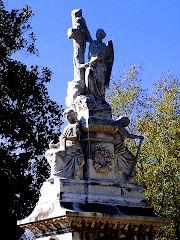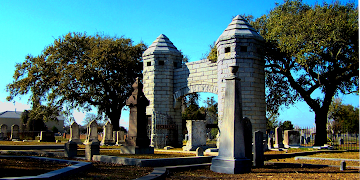It wasn't really the best time of day for most of the photos, Shadows have a habit of falling wherever the sun puts them. And even if I were using a more professional-grade camera than this Kodak, you still have to contend with the lack of talent on the part of the photographer. Even the best equipment and conditions can't overcome that limitation.
Heck, I don't even remember how to use half the settings on the consumer-grade Kodak most of the time, so I can't really fault the time-of-day.
And the quality of the camera probably works in my favor -- Higher-end cameras tend to be less forgiving, and would likely make my ineptitude easier to spot
(or at least, harder to ignore). Besides, I like this little Kodak.
But here be the pictures, in any case.
The Bethany and St. Lawrence Cemeteries adjoin Magnolia, and I couldn't help wandering into those also so the photos are really from all three.
It is still an active cemetery containing ~35,000 graves, tombs, and mausoleums, covering ~130 acres with ~50 acres set aside for new graves.
Fourteen of the signatories to the original Ordinance of Secession are interred here, among other notable historic figures such as former governors, senators, cabinet members, etc.
Horace L. Hunley, the engineer who designed the earliest submarines used in wartime, was buried here on Nov 8, 1863, with full military honors.
Fittingly, Lieutenant George E. Dixon, the Commander of the submarine CSS H.L. Hunley, was buried here in 2004 with the seven other
crewmembers
Arnold Becker, Cpl C. F. Carlsen, Frank Collins, C. Lumpkin, Augustus Miller, Joseph F. Ridgaway, and James A. Wicks.
who died after sinking the Union sloop USS Housatonic, joining Horace L. Hunley himself and all the members of the boat's earlier crews.

Graves of the famous and the infamous infamous can be found here. Statesmen, soldiers, authors, poets, and artists share the grounds with pirates, bootleggers, gangsters, and other assorted scoundrels including the occasional whorehouse Madame.
Yes, you read that correctly. I said "whorehouse Madame". The history of the so-called "holy city" of Charleston is not without its share of unholiness. People are still people, regardless of the decade or century. Were it not true, you wouldn't likely be here to read this.
But I'm getting off-track... My train-of thought is de-railing.
There are
entire books written about the subject, if that sort of thing interests you.
I intend to go back sometime when neither of my legs are broken, so I can walk around more and get some better photos.












